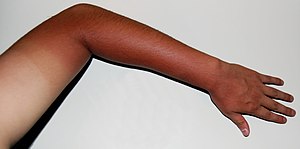Exposure to the Sun

Melanin in the skin protects the body by absorbing solar radiation. In general, the more melanin there is in the skin the more solar radiation can be absorbed. Excessive solar radiation causes direct and indirect DNA damage to the skin and the body naturally combats and seeks to repair the damage and protect the skin by creating and releasing further melanin into the skin's cells. With the production of the melanin, the skin color darkens, but can also cause sunburn. The tanning process can also be created by artificial UV radiation.
There are two different mechanisms involved. Firstly, the UVA-radiation creates oxidative stress, which in turn oxidizes existing melanin and leads to rapid darkening of the melanin, also known as IPD (immediate pigment darkening). Secondly, there is an increase in production of melanin known as melanogenesis. Melanogenesis leads to delayed tanning and first becomes visible about 72 hours after exposure. The tan that is created by an increased melanogenesis lasts much longer than the one that is caused by oxidation of existing melanin. Tanning involves not just the increased melanin production in response to UV radiation but the thickening of the top layer of the epidermis, the stratum corneum.
A person's natural skin color affects their reaction to exposure to the sun. Generally, those who start out with darker skin color and more melanin have better abilities to tan. Individuals with very light skin and albinos have no ability to tan. The biggest differences resulting from sun exposure are visible in individuals who start out with moderately pigmented brown skin: the change is dramatically visible as tan lines, where parts of the skin which tanned are delineated from unexposed skin.
Modern lifestyles and mobility have created mismatch between skin color and environment for many individuals. Vitamin D deficiencies and UVR overexposure are concerns for many. It is important for these people individually to adjust their diet and lifestyle according to their skin color, the environment they live in, and the time of year. For practical purposes, such as exposure time for sun tanning, six skin types are distinguished following Fitzpatrick (1975), listed in order of decreasing lightness:
Fitzpatrick scaleedit
The following list shows the six categories of the Fitzpatrick scale in relation to the 36 categories of the older von Luschan scale:
| Type | Also called | Sunburning | Tanning behavior | Von Luschan's chromatic scale |
|---|---|---|---|---|
| I | Light, pale white | Always | Never | 0–6 |
| II | White, fair | Usually | Minimally | 7–13 |
| III | Medium, white to light brown | Sometimes | Uniformly | 14–20 |
| IV | Olive, moderate brown | Rarely | Easily | 21–27 |
| V | Brown, dark brown | Very rarely | Very easily | 28–34 |
| VI | Very dark brown to black | Never | Never | 35–36 |
Dark skin with large concentrations of melanin protects against ultraviolet light and skin cancers; light-skinned people have about a tenfold greater risk of dying from skin cancer, compared with dark-skinned persons, under equal sunlight exposure. Furthermore, UV-A rays from sunlight are believed to interact with folic acid in ways that may damage health. In a number of traditional societies the sun was avoided as much as possible, especially around noon when the ultraviolet radiation in sunlight is at its most intense. Midday was a time when people stayed in the shade and had the main meal followed by a nap, a practice similar to the modern siesta.
Comments
Post a Comment